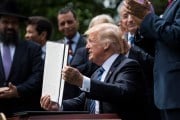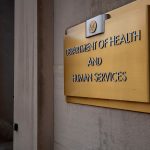Under the Biden administration, the environmental justice movement had a historic platform to bring clean water and air to communities that have suffered from pollution. It was a boon to the grassroots movement, which started in the 1980s in response to a pattern of permitting landfills and polluting industries in neighborhoods that were disproportionately Black, Brown and low-income.
In the past four years, advisory councils were created — with many of the positions filled by women of color, who have long been leaders in environmental justice spaces — and offices opened to spearhead the work on the federal level. During that time, the administration also earmarked billions of dollars to address longstanding environmental issues, and to help these communities adapt to the climate crisis.
But as President Donald Trump took office for a second time, all that momentum at the federal level disappeared, seemingly overnight. An executive order issued on inauguration day took aim at dismantling diversity, equity and inclusion initiatives, and environmental justice. As a result, any mention of the work is being scrubbed from government websites and funding has been paused.
For Jalonne White-Newsome, who led the first ever office on environmental justice in the White House, the shift has been jarring if not unexpected. Still, she’s not undaunted. Through her over three decades of working in environmental justice — starting from her youth in Detroit, Michigan — there is one thing she knows: The movement, at its core, is driven by everyday people who will continue to advocate for their communities.
“Environmental justice did not start with the federal government,” she said. “Nor will it end with the federal government.”
The 19th spoke with White-Newsome, formerly the federal environmental justice officer for the White House Council on Environmental Quality, about the Trump administration’s recent attacks on her work and how the movement responds now.
This interview has been edited for length and clarity.
Jessica Kutz: What is it like to see the new administration issue executive orders aimed at dismantling environmental justice, work that you played a part in implementing?
Jalonne White-Newsome: I mean, it’s crushing, right? It is offensive. It’s really hard because we have really tried to work hard over these past four years to create a foundation that our federal family could build on.To see a lot of that dismantled, to see our information wiped off websites, to really try and eliminate the trace of any environmental justice work, it’s very frustrating.
How do you think this pull back in funding will affect the momentum of the movement? Is there work that was done under Biden that might be protected from this shift?
I’ve had so many community leaders over the past couple years come up to me, folks that have been in the movement for decades and decades, to say there has never been this amount of funding and resources to support environmental justice.
And so our agency partners worked really, really hard to try and get as much money out as possible [before the Trump administration]. I mean, they were grinding very hard.
I know there are groups that are positioning to make sure that communities can keep the funds that were obligated to them. So that is happening right now. Where it gets sticky is some of the funds were kind of in that period of not being obligated. [Especially with] the current administration’s review of anything that remotely thinks, talks or looks like equity or environmental justice.
I’m not a lawyer. Is that legal? Can they actually do that? I don’t know. But it’s a fear tactic, right? And they’re trying to cause fear and confusion, and they have been successful. But we have great partners that have a lot of knowledge and passion that are going to protect our folks that have received these funds to continue to do the great work that they’re doing on the ground.
-
Read Next:
What are your concerns about this political shift away from DEI and environmental justice work?
People, in my humble opinion, can conflate equity and environmental justice, they see it as the same thing. But it isn’t. Equity is really about access and environmental justice is about making sure that you can turn on your water and drink it, that you have an opportunity to be a part of a process that really governs your health.
This whole political shift around equity or environmental justice with this current administration, is driven by fear, this fear of losing power or losing control, which is undergirded by racism.
When you think about the work of previous administrations that had started to tackle and address environmental racism, to where we were with the Biden-Harris administration and all of the strides that we’ve made, that scares people, because we actually had Black and Brown and Indigenous and poor communities who had more power. We were giving resources to people. We were giving folks political capital. We were hearing their voices, and that scared people.
How do you see the movement and its leaders changing or shifting strategies under an administration that has placed the work in its crosshairs?
What is beautiful about the environmental justice movement is that it is made up of people that are so resilient, that have so much fortitude. And I was talking to a group of EJ leaders the other day and they’re like, “We’ve been here before.” I mean, this is not new. What is amazing and powerful is that we have learned, just as in many cases, what worked before and how we need to shift our strategy and thinking to prepare for and plan for 2029. That is where the energy is right now.
Yes, there is a little bit of grief. But EJ at its crux is local. We still need to have a voice and make sure that the federal government knows we’re present. But, where we’re going to spend most of our energy, where I see the movement already shifting and moving is really the things that we can have more local control over, and that is local fights, and with the state government, and work with entities like philanthropy and private industry that are probably going to have to step in and step up to help support some of the funding gaps that we will most likely see from this current administration on things that we care about.
I am very hopeful and excited, because it is just a renewed energy, and I think that’s going to carry us through the next four years.
-
Read Next:
What ways do you see these other actors like local governments or companies being partners in the work?
It’s not time to backslide, but it is time to step up. We’ve seen again, some of the commitments from private industry, whether it be Apple or Costco or whatever, that regardless of what’s happening at the federal government level they’re sticking to their DEI goals and those values.. The federal government doesn’t drive everything in this country. We are still in control of the things that we can control. You have companies that have created sustainability goals that might have something about environmental justice and something about equity in there. Well, it’s time to keep going, keep funding and keep supporting it. But what’s most important is tracking what is the benefit of actually having equity goals and environmental justice goals? So we can begin to create the business case of why this is important. Morally it just makes sense to do what’s right. But sometimes people need more than that.
From a state and local level, it is making sure that we have people in power that are informed and aware of what environmental injustice is. And when you talk about local elections and getting people in leadership that have that awareness that is critically important, because when you think about decisions on permits or zoning, that is where the rubber hits the road in most of these communities.
I’m also thinking about people that are maybe newer to the environmental justice movement and might be discouraged by the new administration. What advice do you have for them?
The cool thing about the EJ movement is that it is strongly intergenerational. So you have leaders that have been in the game for like 50 to 60 years. But then you have folks that are in their early 20s. And so what I have witnessed is the wisdom and experience of our EJ elders to really comfort the young folks and say, “Hey, this is nothing new. We’ve been here before, and let’s figure out a strategy to go forward.” And so not only is the intergenerational piece important for the movement to continue, because our elders can’t continue this forever, but it’s also that our young folks need to know that it will be OK, and our elders bring that source of hope and that source of continuity.
In my office, my staff was fairly young, and folks were crushed after the election. They were crushed over the past couple weeks. I think what’s been most important is to make sure that we have a community that people can come to and depend on, rely on. My staff members that are now out of the White House, we meet on a weekly basis, and we are plotting and planning like, what is it that we can do to continue this work and build on the foundation of the last administration? I think what we have to remind folks is our right to grieve, but then you have to turn that energy into something positive and something that, again, will continue the movement.
For those that might be new [to EJ] find out what group is working in your community on an issue that you care about. Go to a public meeting. We should get better about finding those tangible things that just regular folks that have no idea of this environmental stuff can care about and get engaged in and start taking steps to do something.







